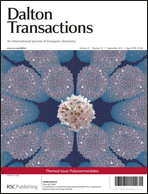Isopolyoxometalates derived from arylstibonic acids with “reverse-Keggin ion” structures based on [M(RSb)12O28] cores, M = Co(ii) or Zn(ii)†
Abstract
The preparations and structures are described of four new polyoxostibonates, [Co(p-MeC6H4Sb)12O28{Co(H2O)3}4]Cl2·6H2O, [Co(p-ClC6H4Sb)12O28{Co(H2O)3}4]Cl2·22H2O, (PhCH2NMe3)2[Zn(p-ClC6H4Sb)12O28Zn4Cl2.54Br1.46]·8MeCN·H2O and [BaCoH4(p-MeC6H4Sb)O28]·5H2O. Each of these has a framework of 12 (RSb) groups linked by 28 O atoms, with one transition metal ion in a tetrahedral site in the centre. Other metal ions are coordinated to the polyhedral faces. Three of the complexes have the ε Keggin ion geometry, while the fourth is a δ isomer.
![Graphical abstract: Isopolyoxometalates derived from arylstibonic acids with “reverse-Keggin ion” structures based on [M(RSb)12O28] cores, M = Co(ii) or Zn(ii)](/en/Image/Get?imageInfo.ImageType=GA&imageInfo.ImageIdentifier.ManuscriptID=C2DT30341H&imageInfo.ImageIdentifier.Year=2012)
- This article is part of the themed collection: Polyoxometalates

 Please wait while we load your content...
Please wait while we load your content...